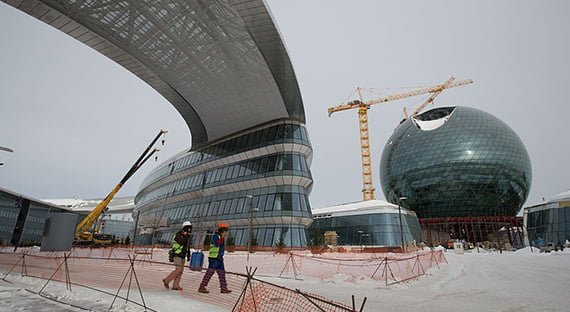
Construction workers walk past the Astana Expo 2017 Sphere in Astana, Kazakhstan. Economic activity is picking up in the country, says the IMF's report (photo: Andrey Rudakov/Bloomberg via Getty Images)
Six Things to Know About the Economic Outlook for the Caucasus and Central Asia
May 4, 2017
Growth in the Caucasus and Central Asia is expected to pick up this year to 3.1 percent from 2.4 percent in 2016 as the external environment improves—firmer growth in Russia, an upgraded outlook for China, and a partial recovery in commodity prices, says the IMF’s latest regional forecast.
Related Links
But, to bring growth back to the levels of the previous decade, the region will need to embark on fundamental reforms to build economic resilience and reduce dependence on commodity exports and remittances.
The IMF’s Regional Economic Outlook for the Middle East and Central Asia, officially launched on May 2 in Dubai and May 4 in Almaty, outlines the six things to know about the region’s current growth prospects and the policies to strengthen them.
- Growth is set to pick up in 2017 as external factors improve. After a disappointing 2016, growth is expected to be 3.1 percent in 2017 and 4.1 percent in 2018 (see table). This is largely due to firmer growth in Russia, an upgraded outlook for China, and a partial recovery in commodity prices.
- Fiscal support and currency adjustment helped mitigate some of the impact of external shocks. Increases in public expenditure provided much-needed support to domestic demand. At the same time, exchange rate depreciations—and, in many cases, increased exchange rate flexibility—partly compensated for the fiscal and external losses arising from the decline in commodity prices and the slowdown in remittances. Depreciations helped maintain the value of external and fiscal revenues in local currency, and made exports somewhat more attractive.
- But these actions have left the region more vulnerable—with higher deficits and debt. With budget revenues subdued, increased public spending led to wider fiscal deficits—especially among oil importers, like the Kyrgyz Republic—effectively reducing the policy space to cope with any future shocks. Public debt, while still low relative to international standards, increased in many countries, and further debt accumulation is anticipated over the next few years. Currency depreciation also played an important role—almost half of the increase in public debt since 2014 resulted from valuation changes because a large share of public debt is denominated in foreign currency.
- Fiscal consolidation is needed, and should include both spending and revenue measures. Countries have taken steps to cut public investment, which, in some instances, reflects the appropriate reversal of past investment booms that generated little improvement in productivity or growth. More broadly, countries need to strengthen the efficiency of public spending and preserve critical social spending that protects the vulnerable. Countries should also identify new sources of revenues, which would lessen their dependence on commodities.
- Financial sector weaknesses call for repair. The economic slowdown, coupled with exchange rate depreciation, hit the heavily dollarized financial sectors hard. With few exceptions, restructured and overdue loans increased as borrowing costs in foreign currency rose, credit contracted, and banks lost reserves set aside to protect themselves in difficult times. To tackle these financial sector issues, it is critical to identify bad loans and capital needs, as well as provide—under strict conditions—support to troubled banks. Additionally, liquidation of bad assets and openness to fresh capital should be undertaken transparently and in a way that promotes competition. Crisis management and resolution frameworks should be strengthened, and regulation should be fully enforced.
- Structural reforms are more important than ever to sustain higher growth. Medium-term growth is expected to remain below the historical average, reflecting the still relatively subdued external outlook, and domestic growth impediments—weak financial sectors and lack of diversification amid inefficient business environments. Reforms to diversify away from oil and other commodities, and reduce the reliance on remittances—such as the 100 Concrete Steps in Kazakhstan and the Four Point Reform Plan in Georgia—would help countries achieve that goal, while building resilience against external shocks. Due to improving external conditions, there is the risk that such reforms could be delayed. This would potentially impede further gains in living standards in the region.

"Capital and investment flows can be the lifeblood of an economy, and so it is important that the countries in the region take decisive steps toward rectifying their financial sector weaknesses,” said Jihad Azour, the Director of the IMF’s Middle East and Central Asia Department.



